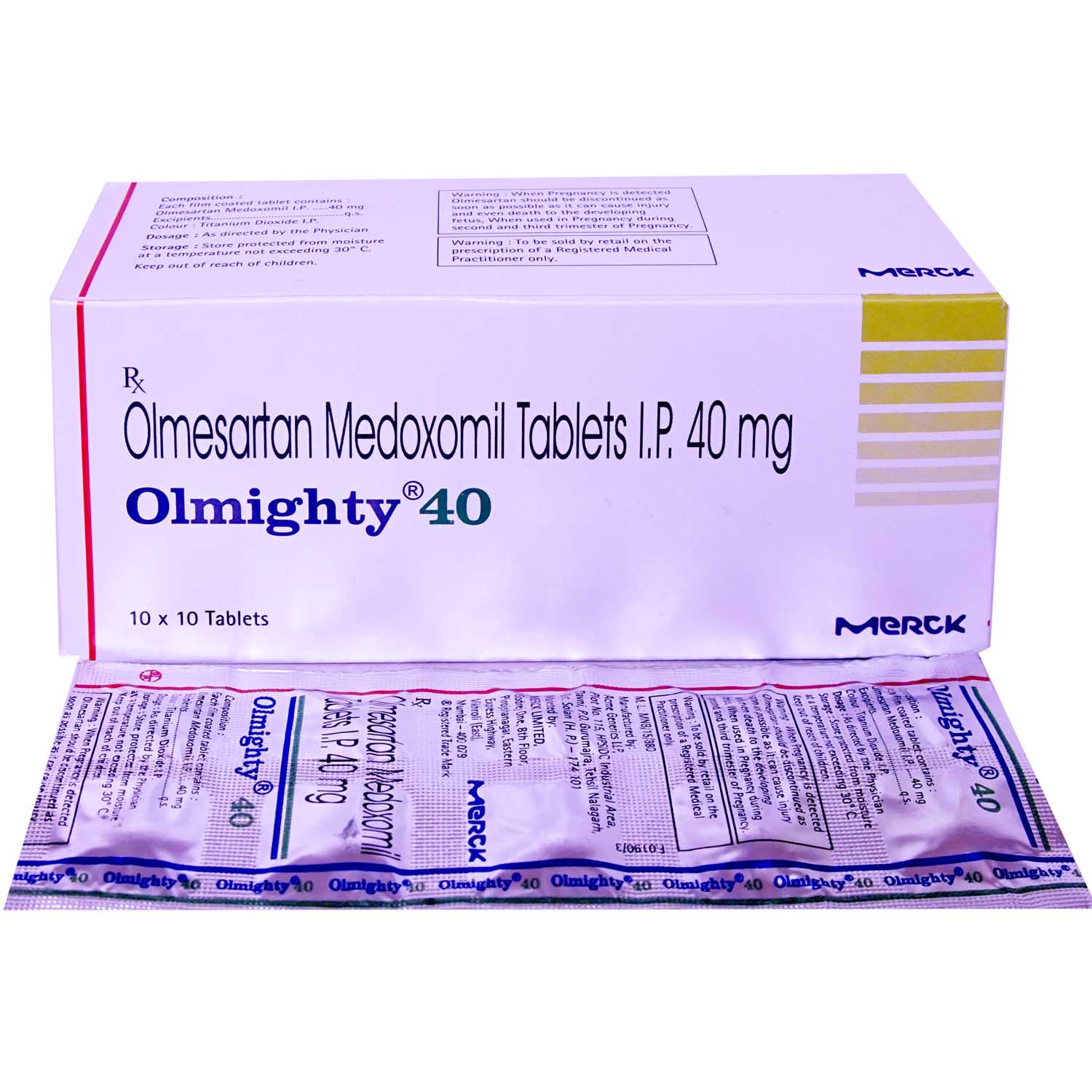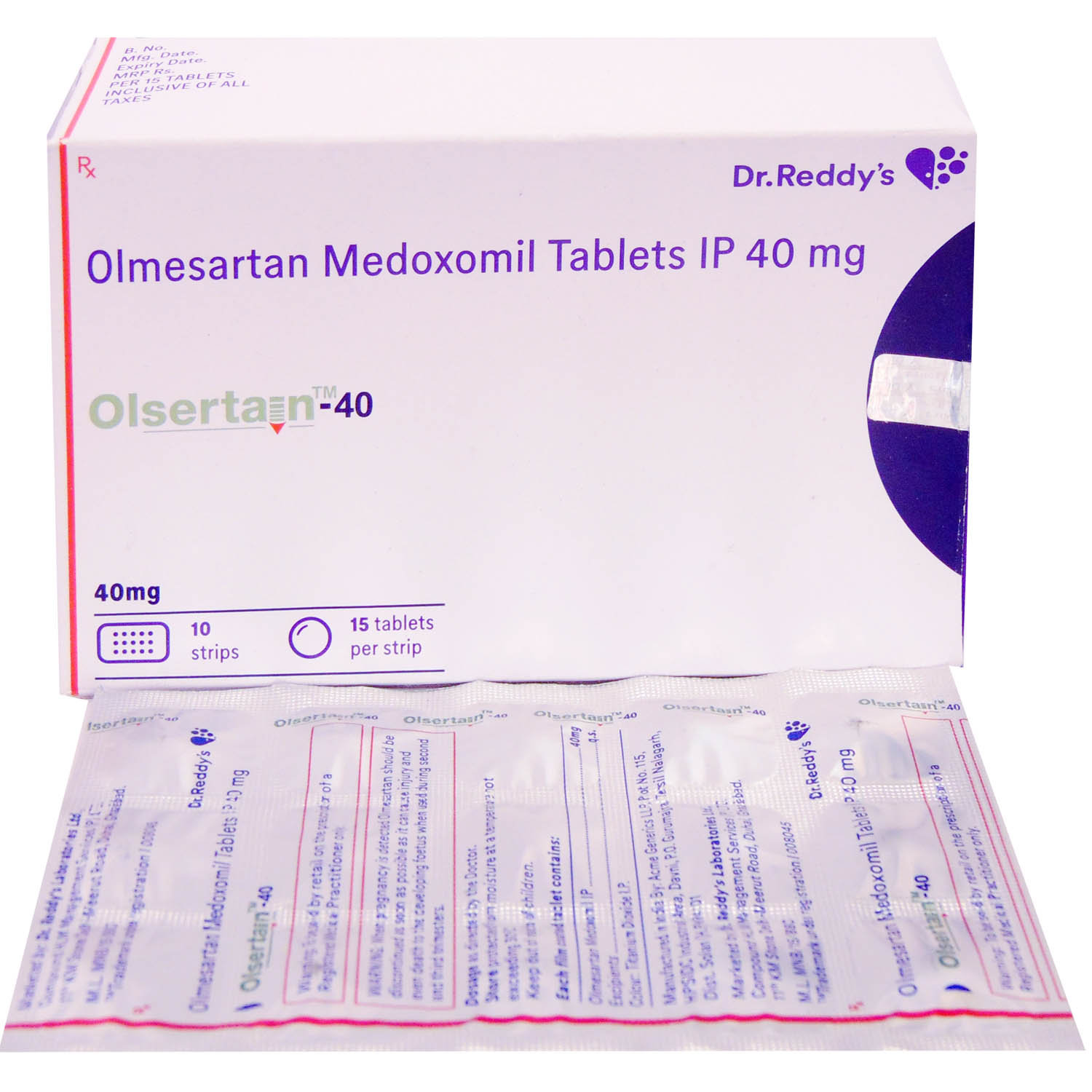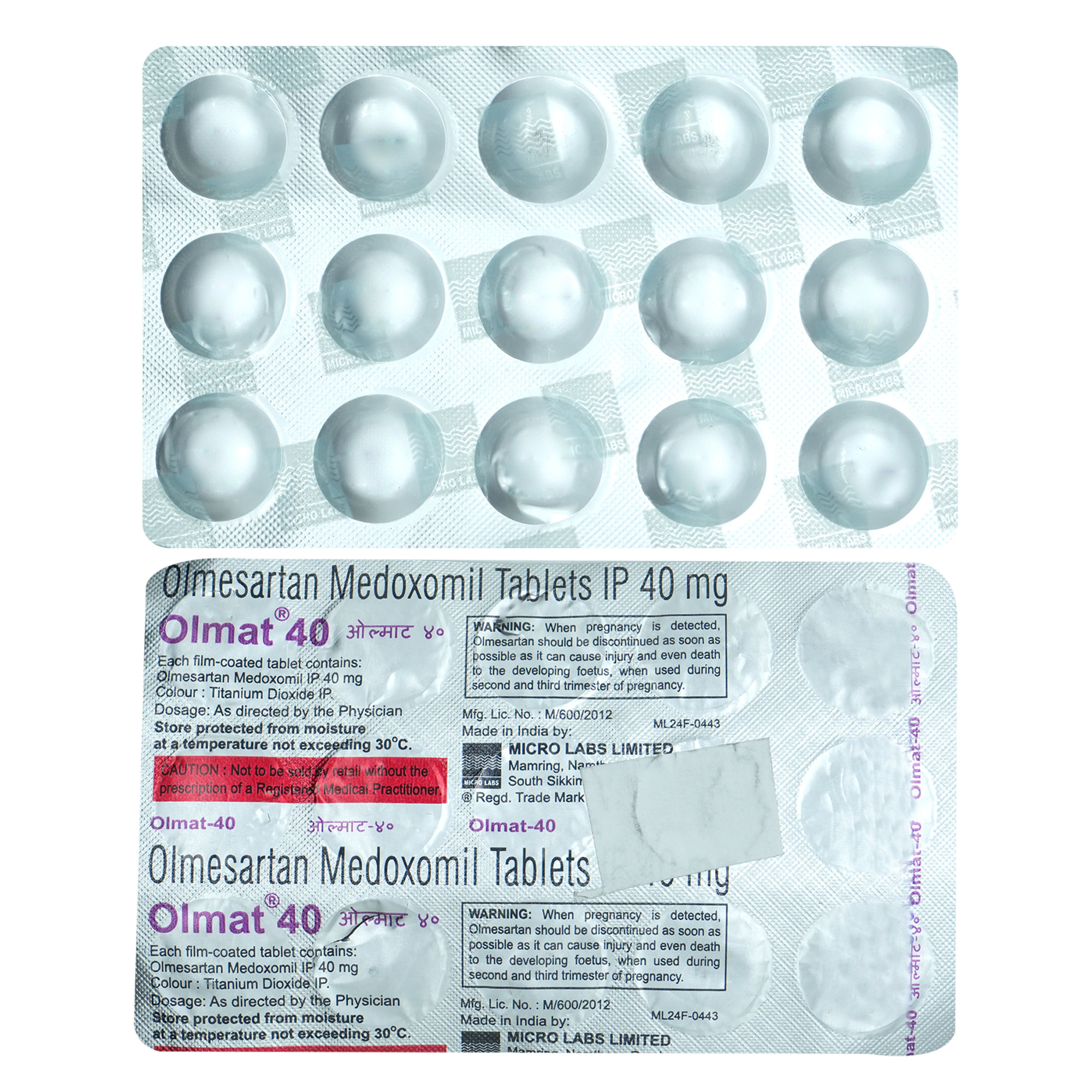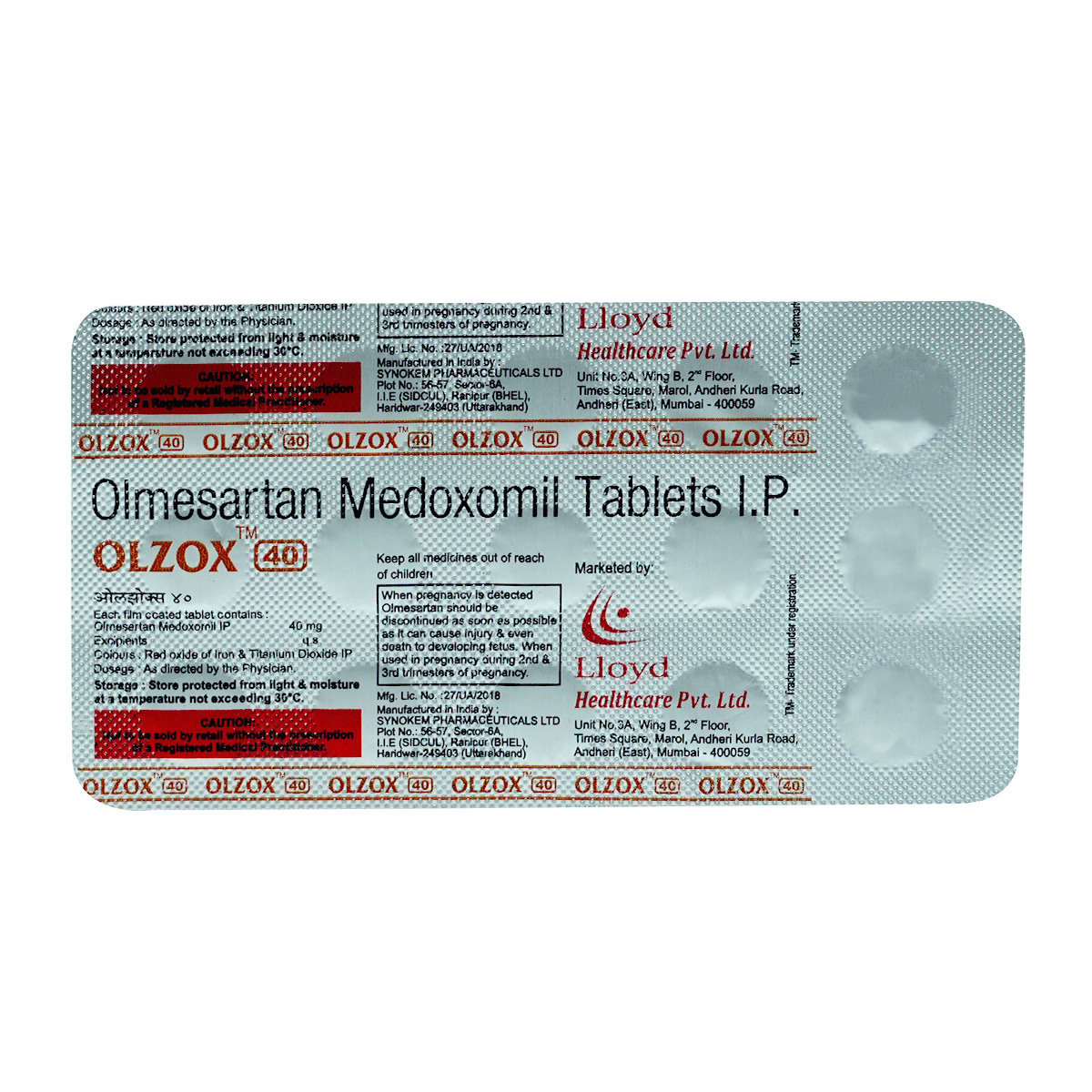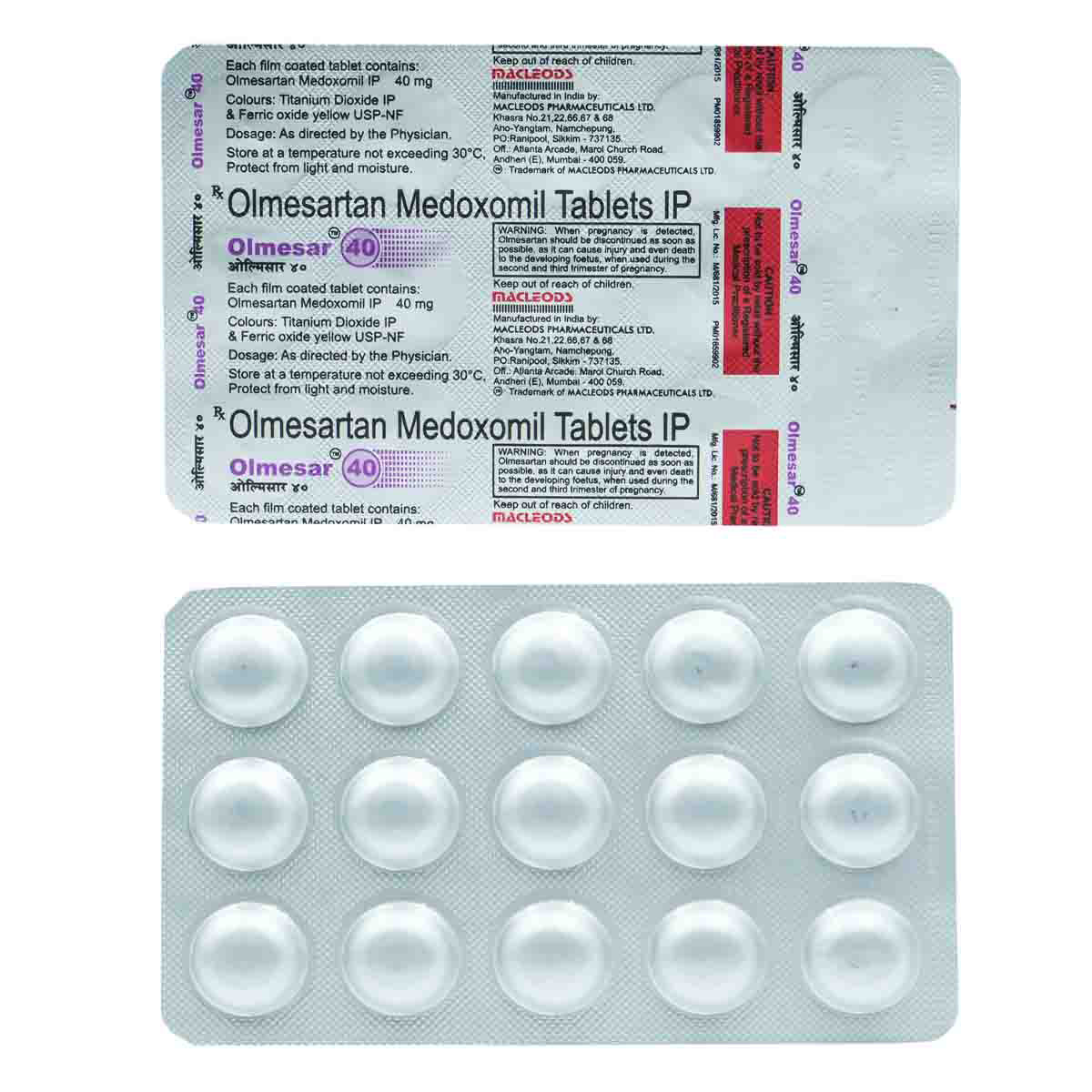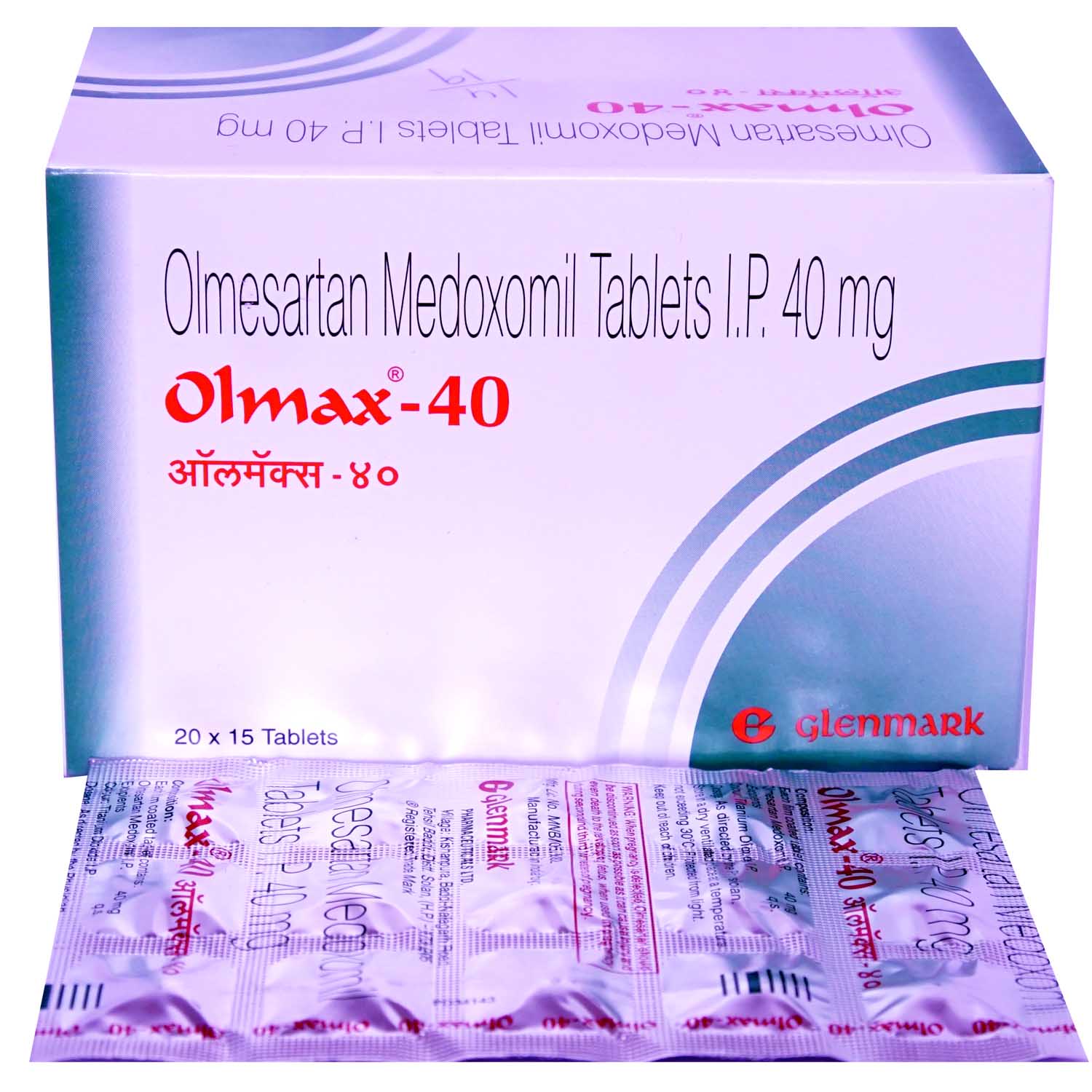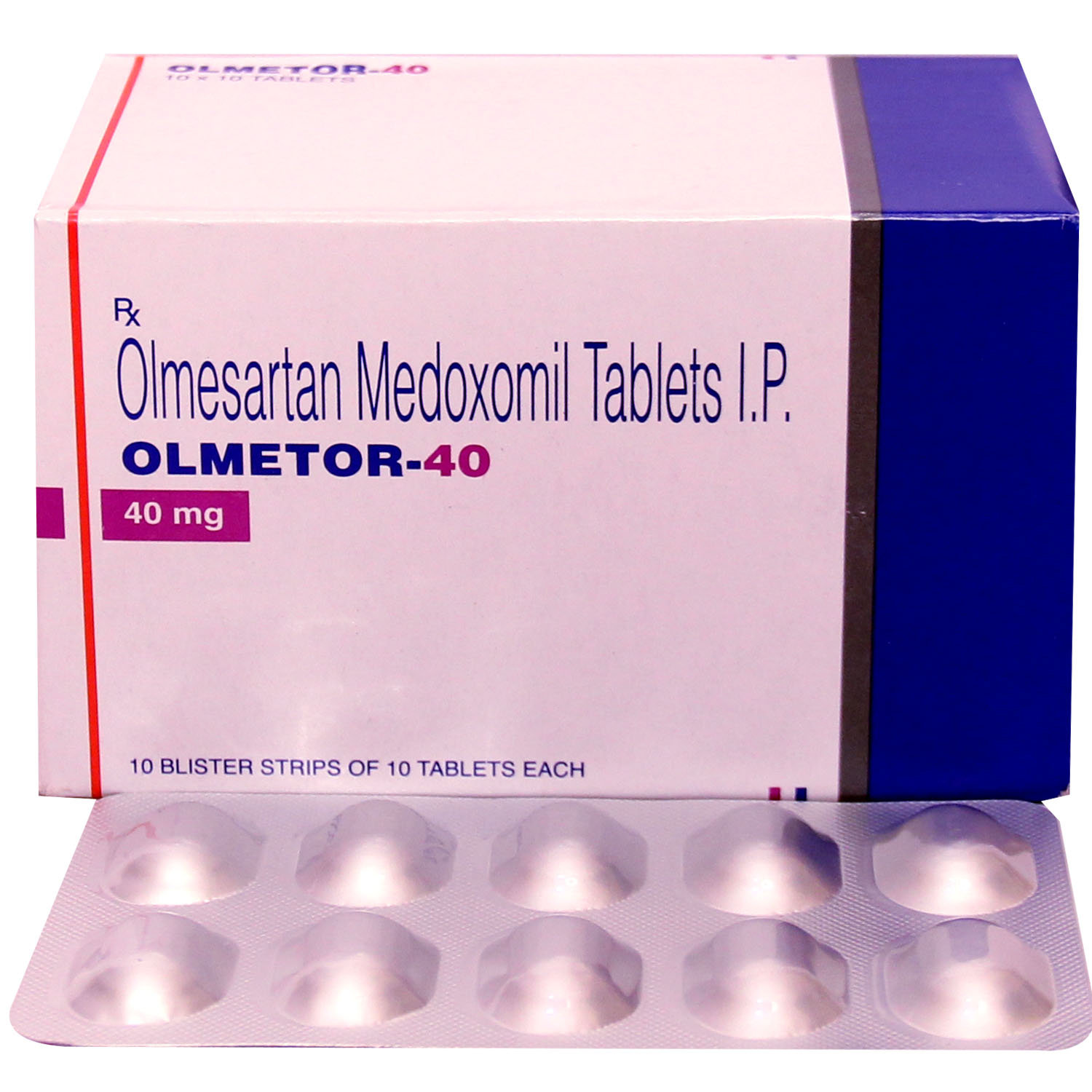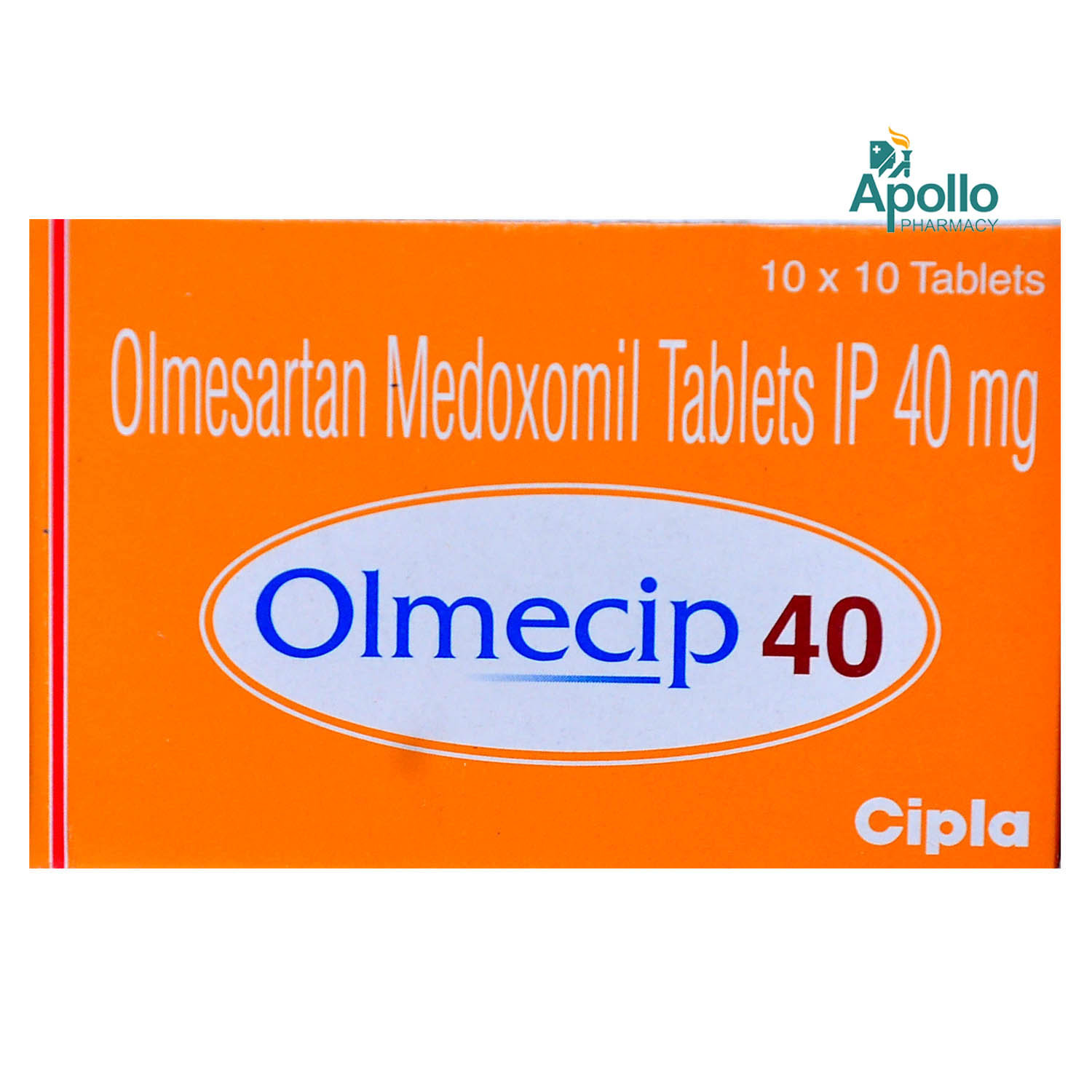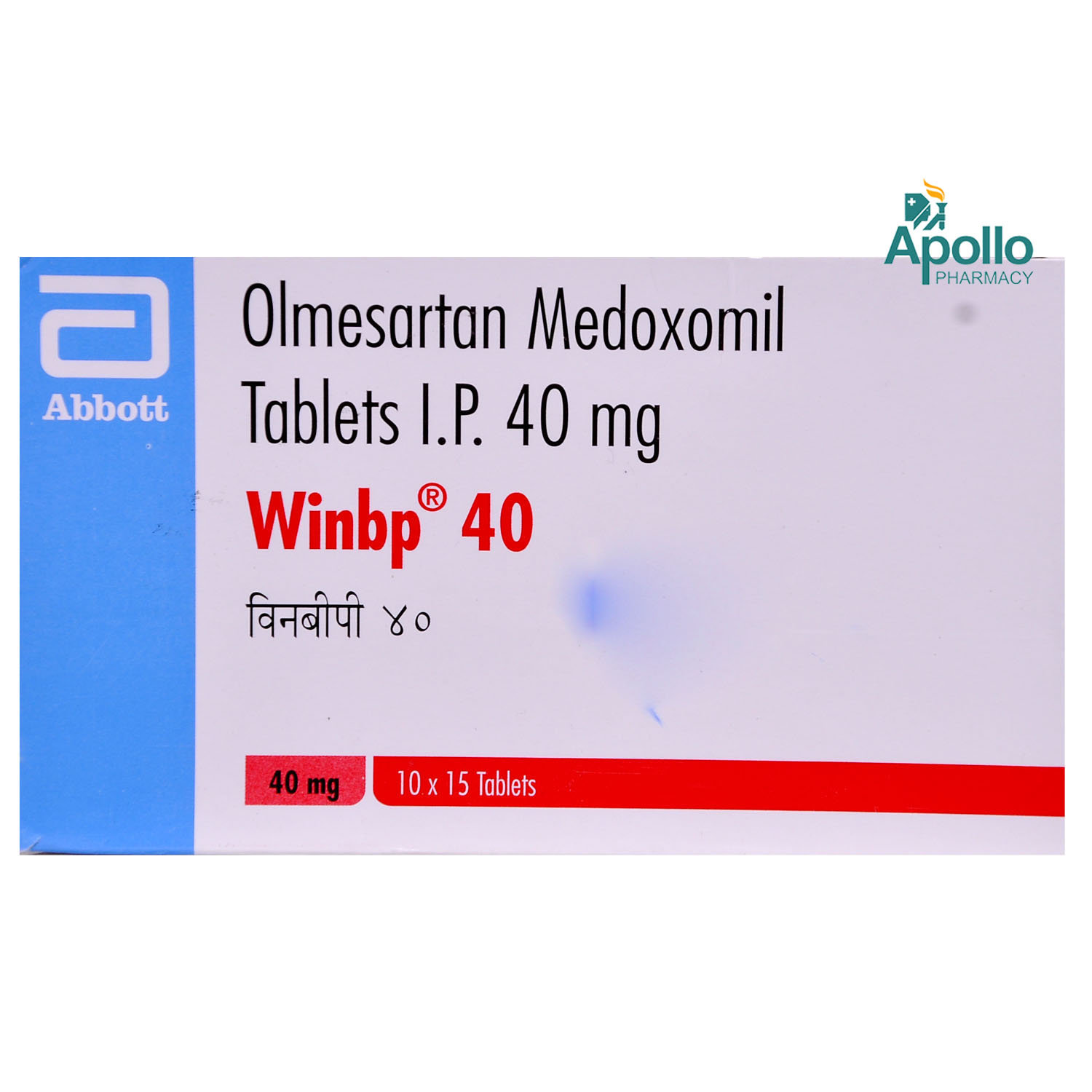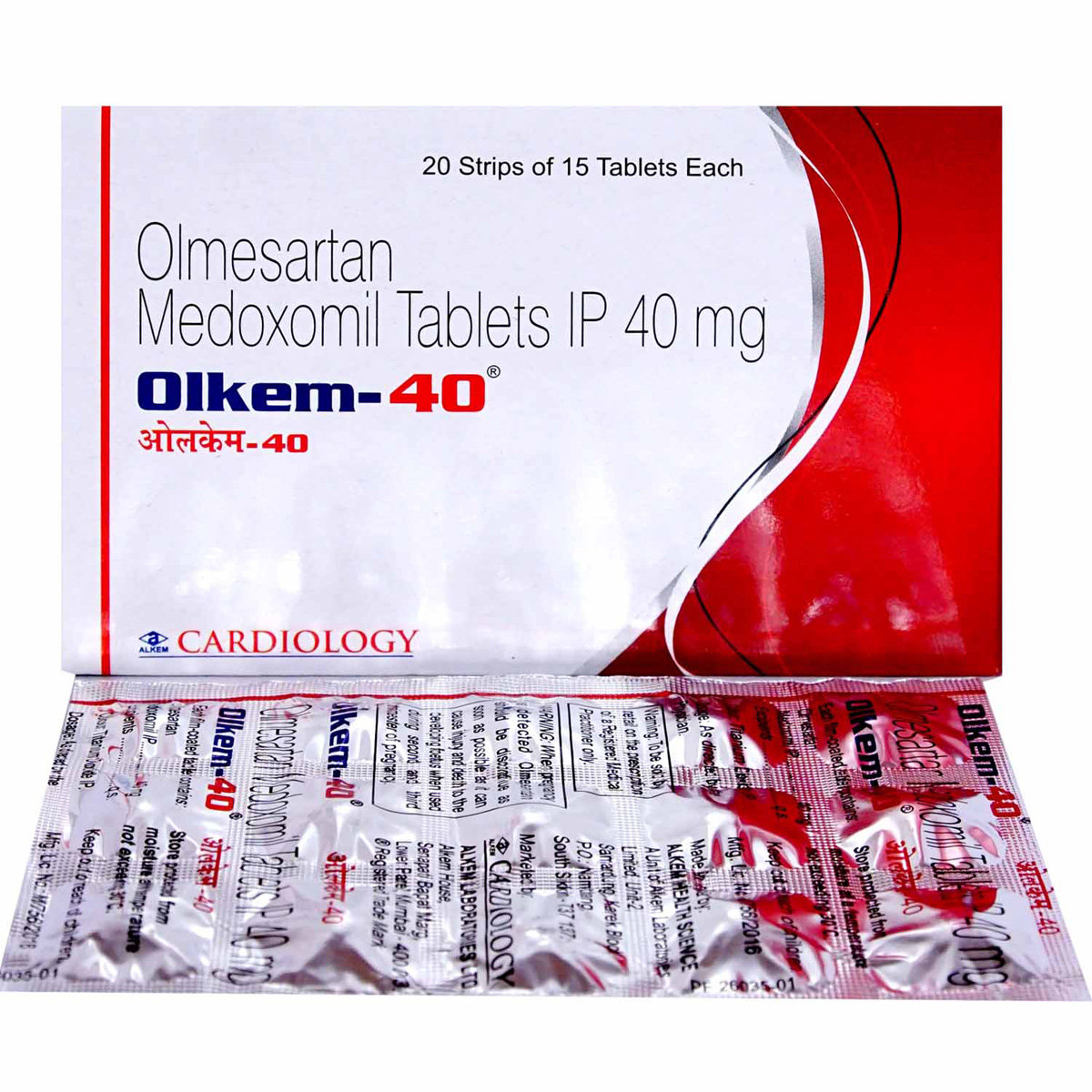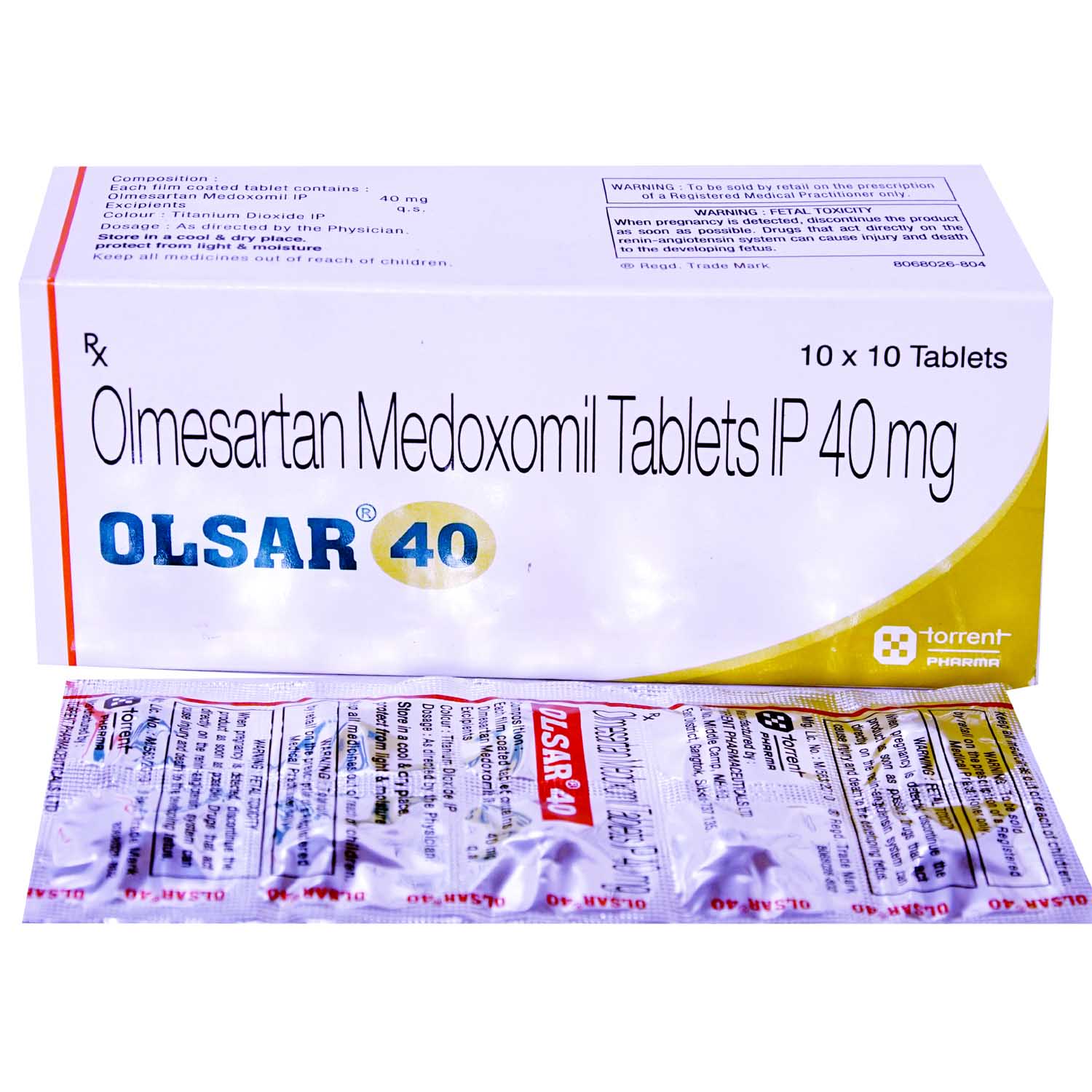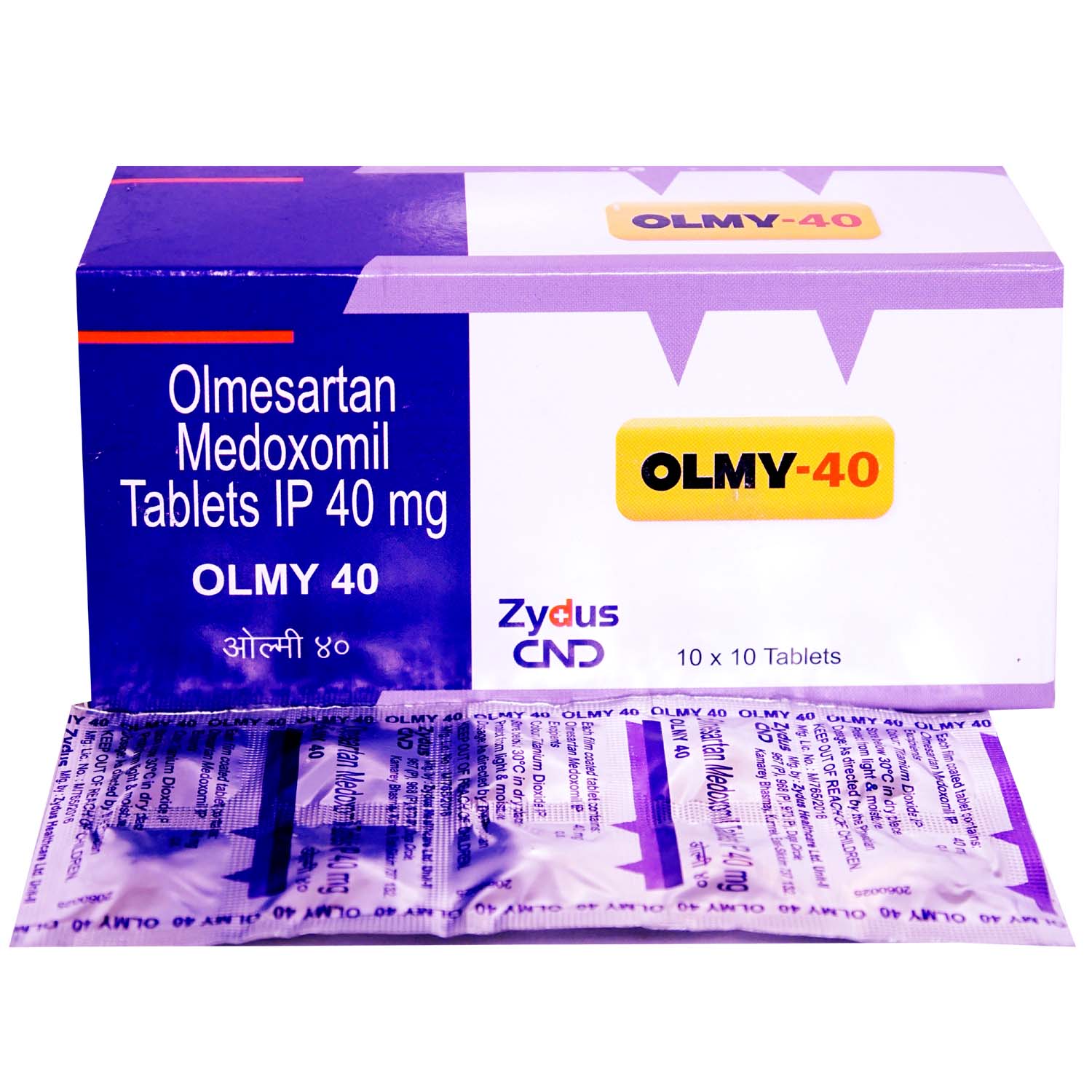Olsacare-40 Tablet 10's


MRP ₹178
(Inclusive of all Taxes)
₹26.7 Cashback (15%)
Provide Delivery Location
Online payment accepted
 Prescription drug
Prescription drugWhats That
Composition :
Manufacturer/Marketer :
Consume Type :
Return Policy :
Expires on or after :
About Olsacare-40 Tablet
Olsacare-40 Tablet belongs to a group of medications called 'anti-hypertensives' primarily used to treat high blood pressure (hypertension). High blood pressure is a chronic (long-term) condition in which blood pressure is elevated persistently at higher than normal levels. If left untreated, this condition can increase the risk of heart-related diseases like heart attack, heart failure, stroke, irregular heartbeat, and other complications.
Olsacare-40 Tablet contains ‘Olmesartan medoxomil’ which is a prodrug and is hydrolyzed to olmesartan during absorption from the gastrointestinal tract. It is an angiotensin-II receptor blocker (ARB) that narrows the blood vessels increasing the blood pressure, therefore blocking angiotensin can result in the widening of the narrowed blood vessels. This effect allows the blood to flow more smoothly in the blood vessels.
Take Olsacare-40 Tablet as prescribed. Your doctor will advise you on how often you take Olsacare-40 Tablet based on your medical condition. The common side-effects of Olsacare-40 Tablet are dizziness, headache, nausea, indigestion, diarrhea, stomach pain, and sore throat. Most of these side effects of Olsacare-40 Tablet do not require medical attention and gradually resolve over time. However, if the side effects persist or worsen, please consult your doctor.
Do not take Olsacare-40 Tablet if you are allergic to ‘olmesartan medoximil’ or any ingredients present in it. Olsacare-40 Tablet should not be used in pregnant women, patients suffering from jaundice (yellowing of the skin and eyes) or gallbladder blockage, patients having diabetes or kidney failure, and using blood pressure-lowering medicine containing aliskiren. Inform your doctor if you are taking potassium supplements or any other prescription or non-prescription drugs.
Uses of Olsacare-40 Tablet
Directions for Use
Medicinal Benefits
Olsacare-40 Tablet contains ‘Olmesartan medoximil’ which belongs to the class of ‘antihypertensives’. It is primarily used to reduce high blood pressure. It is an angiotensin-II receptor blocker (ARB) that blocks the hormone angiotensin. Angiotensin narrows the blood vessels increasing the blood pressure, therefore blocking angiotensin can result in the widening of the narrowed blood vessels. This effect allows the blood to flow more smoothly in the blood vessels and thus lowering blood pressure.
Storage
- Inform your doctor about dizziness symptoms. They may adjust your medication regimen or prescribe additional medications to manage symptoms.
- Follow your doctor's instructions for taking medication, and take it at the same time every day to minimize dizziness.
- When standing up, do so slowly and carefully to avoid sudden dizziness.
- Avoid making sudden movements, such as turning or bending quickly, which can exacerbate dizziness.
- Drink plenty of water throughout the day to stay hydrated and help alleviate dizziness symptoms.
- If you're feeling dizzy, sit or lie down and rest until the dizziness passes.
- Track when dizziness occurs and any factors that may trigger it, and share this information with your doctor to help manage symptoms.
- If you experience symptoms like coughing, wheezing, chest tightness, or difficulty breathing after taking medication, seek medical attention immediately.
- Your healthcare provider will work with you to stop the medication causing the reaction, start alternative treatments, and provide supportive therapy.
- To manage symptoms and prevent complications, follow your doctor's advice to use inhalers or nebulizers as prescribed, practice good hygiene, avoid irritants, stay hydrated, and get plenty of rest.
- Regularly track your symptoms and report any changes or concerns to your healthcare provider.
- Inform Your Doctor: Notify your doctor immediately about your diarrhoea symptoms. This allows them to adjust your medication or provide guidance on managing side effects.
- Stay Hydrated: Drink plenty of fluids to replace lost water and electrolytes. Choose water, clear broth, and electrolyte-rich drinks. Avoid carbonated or caffeinated beverages to effectively rehydrate your body.
- Follow a Bland Diet: Eat easy-to-digest foods to help firm up your stool and settle your stomach. Try incorporating bananas, rice, applesauce, toast, plain crackers, and boiled vegetables into your diet.
- Avoid Trigger Foods: Steer clear of foods that can worsen diarrhoea, such as spicy, fatty, or greasy foods, high-fibre foods, and dairy products (especially if you're lactose intolerant).
- Practice Good Hygiene: Maintain good hygiene to prevent the spread of infection. To stay healthy, wash your hands frequently, clean and disinfect surfaces regularly, and avoid exchanging personal belongings with others.
- Take Anti-Diarrheal Medications: If your doctor advises, anti-diarrheal medications such as loperamide might help manage diarrhoea symptoms. Always follow your doctor's directions.
- Keep track of your diarrhoea symptoms. If they don't get better or worse or are accompanied by severe stomach pain, blood, or dehydration signs (like extreme thirst or dark urine), seek medical help.
- Talk to your doctor about your back pain and potential medication substitutes or dose changes.
- Try yoga or Pilates and other mild stretching exercises to increase flexibility and strengthen your back muscles.
- To lessen the tension on your back, sit and stand upright and maintain proper posture.
- To alleviate discomfort and minimize inflammation, apply heat or cold packs to the afflicted area.
- Under your doctor's supervision, think about taking over-the-counter painkillers like acetaminophen or ibuprofen.
- Make ergonomic adjustments to your workspace and daily activities to reduce strain on your back.
- To handle tension that could make back pain worse, try stress-reduction methods like deep breathing or meditation.
- Use pillows and a supportive mattress to keep your spine in the right posture as you sleep.
- Back discomfort can worsen by bending, twisting, and heavy lifting.
- Speak with a physical therapist to create a customized training regimen to increase back strength and flexibility.
- Limit fried foods and red meat.
- Increase your intake of whole foods such as vegetables, fruits, tree nuts and beans.
- Avoid air pollutants and unhealthy foods.
- Drink lots of water to detoxify your liver.
- Exercise regularly.
- Inform your doctor about the medication you're taking and the UTI symptoms you're experiencing.
- Your doctor may adjust your medication regimen or consider alternative medications or dosages that may reduce the risk of UTIs.
- Drink plenty of water (at least 8-10 glasses a day) to help flush out bacteria. Avoid sugary drinks and caffeine, which can exacerbate UTI symptoms.
- Urinate when you feel the need rather than holding it in. This can help prevent bacterial growth and reduce the risk of UTIs.
- Consider cranberry supplements: Cranberry supplements may help prevent UTIs by preventing bacterial adhesion.
- Monitor UTI symptoms and report any changes to your doctor.
- If antibiotics are prescribed, take them as directed and complete the full course.
- Inform your doctor about your anxiety symptoms so that you doctor may explore potential drug interactions and alter your treatment plan.
- Work with your doctor to adjust your medication regimen or dosage to minimize anxiety symptoms.
- Reduce anxiety symptoms by practicing relaxation techniques like meditation, deep breathing, or yoga.
- Regular self-care activities, such as exercise, healthy food, and adequate sleep, can assist control anxiety.
- Surround yourself with a supportive network of friends, family, or a support group to help manage anxiety and stay motivated.
- Regularly track anxiety symptoms and report any changes to your doctor to ensure your treatment plan is effective and adjusted as needed.
Drug Warnings
Do not take Olsacare-40 Tablet if you are allergic to ‘olmesartan medoximil’ or any other ingredients present in it. Inform your doctor if you have kidney problems, liver disease, heart problems, diabetes or kidney problems and taking blood pressure-lowering medication containing aliskiren. Also, inform your doctor if you are taking any prescription or non-prescription drugs and nutritional supplements. During treatment, seek medical attention if you experience severe, persistent diarrhoea and substantial weight loss. It is not used in children below 2 years of age, pregnant women and should be used with caution in breastfeeding mothers.
Drug-Drug Interactions
Drug-Drug Interactions
Login/Sign Up
Using aliskiren together with olmesartan may increase the risk of serious side effects (kidney problems, low blood pressure, and high potassium levels in the blood).
How to manage the interaction:
Taking Olsacare-40 Tablet with Aliskiren is not recommended as it can cause an interaction, they can be taken if advised by a doctor. You should seek medical attention if you experience nausea, vomiting, weakness, confusion, tingling of the hands and feet, feelings of heaviness in the legs, a weak pulse, or a slow or irregular heartbeat.It is crucial that you continue to consume enough fluids while taking these medications. Do not stop using any medications without consulting a doctor.
Using Olsacare-40 Tablet with Potassium chloride may increase Potassium levels in the blood.
How to manage the interaction:
Although taking Olsacare-40 Tablet together with Potassium chloride may lead to an interaction but can be taken if prescribed by the doctor. However, consult the doctor if you experience nausea, vomiting, weakness, disorientation, tingling in your hands and feet, feelings of heaviness in your legs, a weak pulse, or a slow or irregular heartbeat. It is important to maintain proper fluid intake while taking these medications. Do not stop using any medications without talking to a doctor.
Coadministration of Olsacare-40 Tablet with potassium iodide may increase potassium levels in the blood. (High potassium levels can cause hyperkalemia, which can lead to kidney failure, muscular paralysis, abnormal heart rhythm, and cardiac arrest in extreme cases).
How to manage the interaction:
Although taking Olsacare-40 Tablet together with potassium iodide may lead to an interaction but can be taken if prescribed by the doctor. However, consult the doctor if you experience nausea, vomiting, weakness, disorientation, tingling in your hands and feet, feelings of heaviness in your legs, a weak pulse, or a slow or irregular heartbeat. It is important to maintain proper fluid intake while taking these medications. Do not stop using any medications without talking to a doctor.
Taking Olsacare-40 Tablet with trimethoprim may increase potassium levels in the blood.
How to manage the interaction:
Although taking Olsacare-40 Tablet with trimethoprim may lead to an interaction but can be taken if prescribed by the doctor. However, consult the doctor if you experience nausea, vomiting, weakness, disorientation, tingling in your hands and feet, feelings of heaviness in your legs, a weak pulse, or a slow or irregular heartbeat. Do not stop using any medications without talking to a doctor.
Olsacare-40 Tablet when combined with benazepril may cause low blood pressure, kidney problems, and may increase potassium levels in the blood.
How to manage the interaction:
Although taking Olsacare-40 Tablet with benazepril may lead to an interaction but can be taken if prescribed by the doctor. However, consult the doctor if you experience nausea, vomiting, weakness, disorientation, tingling in your hands and feet, feelings of heaviness in your legs, a weak pulse, or a slow or irregular heartbeat. Do not stop using any medications without talking to a doctor.
Taking lithium with Olsacare-40 Tablet may significantly increase the blood levels of lithium .
How to manage the interaction:
Although taking Olsacare-40 Tablet alongside lithium can lead to interaction, they can be taken if prescribed by a doctor. However, if you develop sleepiness, dizziness, confusion, loose stools, vomiting, muscular weakness, muscle incoordination, a shaking sensation, blurred vision, ringing in the ears, excessive thirst, and/or increased urination, consult a doctor. Do not stop using any medications without talking to a doctor.
Taking Olsacare-40 Tablet with triamterene may increase potassium levels in the blood. (High potassium levels can cause hyperkalemia, which can lead to kidney failure, muscular paralysis, abnormal heart rhythm, and cardiac arrest in extreme cases).
How to manage the interaction:
Although taking Olsacare-40 Tablet with triamterene may lead to an interaction but can be taken if prescribed by the doctor. However, consult the doctor if you experience nausea, vomiting, weakness, disorientation, tingling in your hands and feet, feelings of heaviness in your legs, a weak pulse, or a slow or irregular heartbeat. Do not stop using any medications without talking to a doctor.
When Olsacare-40 Tablet is taken with captopril, it may cause low blood pressure, kidney problems, and may increase potassium levels in the blood.
How to manage the interaction:
Although taking Olsacare-40 Tablet with captopril may lead to an interaction but can be taken if prescribed by the doctor. However, consult the doctor if you experience nausea, vomiting, weakness, disorientation, tingling in your hands and feet, feelings of heaviness in your legs, a weak pulse, or a slow or irregular heartbeat. Do not stop using any medications without talking to a doctor.
Coadministration of Olsacare-40 Tablet with fosinopril may cause low blood pressure, kidney problems, and may increase potassium levels in the blood.
How to manage the interaction:
Although taking Olsacare-40 Tablet together with fosinopril may lead to an interaction but can be taken if prescribed by the doctor. However, consult the doctor if you experience nausea, vomiting, weakness, disorientation, tingling in your hands and feet, feelings of heaviness in your legs, a weak pulse, or a slow or irregular heartbeat. Do not stop using any medications without talking to a doctor.
Coadministration of Olsacare-40 Tablet with perindopril may cause low blood pressure, kidney problems, and may increase potassium levels in the blood.
How to manage the interaction:
Although taking Olsacare-40 Tablet together with perindopril may lead to an interaction but can be taken if prescribed by the doctor. However, consult the doctor if you experience nausea, vomiting, weakness, disorientation, tingling in your hands and feet, feelings of heaviness in your legs, a weak pulse, or a slow or irregular heartbeat. Do not stop using any medications without talking to a doctor.
Drug-Food Interactions
Drug-Food Interactions
Login/Sign Up
Lentils, Orange Juice, Oranges, Raisins, Potatoes, Salmon Dried, Spinach, Sweet Potatoes, Tomatoes, Coconut Water, Beans, Beetroot, Broccoli, Bananas, Apricots, Avocado, Yogurt
How to manage the interaction:
Taking Olsacare-40 Tablet along with potassium-containing salt alternatives and over-the-counter potassium supplements might result in elevated potassium levels in your blood. High potassium levels might result in fatigue, irregular heartbeat, disorientation, tingling in the limbs, or feelings of heaviness in the legs. Avoid potassium-rich foods like tomatoes, raisins, figs, potatoes, lima beans, bananas, plantains, papayas, pears, cantaloupes, mangoes, and potassium-containing salt substitutes. However, if you experience symptoms such as fatigue, irregular heartbeat, disorientation, tingling in the limbs, or feelings of heaviness in the legs consult a doctor.
Diet & Lifestyle Advise
- Keep your weight under control with a body mass index (BMI) of 19.5-24.9.
- Do regular physical activity or exercise for at least 150 minutes per week, or about 30 minutes most days of the week. Doing this can help you to lower your raised blood pressure by about 5 mm of Hg.
- Limit intake of sodium chloride (table salt) in your daily diet to 2300 mg per day or less than 1500 mg is ideal for most adults.
- Limit alcohol intake. One serving for women and two servings for men is advisable.
- Quit smoking as it is the best strategy to lower the risk of heart disease.
- Avoid chronic stress as it can raise your blood pressure. Try to enjoy and spent time with your loved ones to cope with stress and practice mindfulness techniques.
- Monitor your blood pressure daily and if there is too much fluctuation, then immediately contact your doctor.
- Try to include heart-healthy omega-3 fatty acids containing food drinks in your daily diet. You can also use low-fat cooking oil like olive oil, soybean oil, canola oil, and coconut oil to lower your elevated blood pressure.
Side Effects of Olsacare-40 Tablet
- Dizziness
- Headache
- Nausea
- Indigestion
- Diarrhea
- stomach pain
- Sore throat
Habit Forming
Therapeutic Class
All Substitutes & Brand Comparisons
RX
Olmighty 40 Tablet 10's
Merck Ltd
₹112.5
(₹10.13 per unit)
36% CHEAPERRX
Olsertain 40 mg Tablet 15's
Dr Reddy's Laboratories Ltd
₹230.5
(₹13.83 per unit)
13% CHEAPERRX
Olmepath-40 Tablet 10's
Proqol Health Care Pvt Ltd
₹174.5
(₹15.71 per unit)
1% CHEAPER
Product Substitutes
Drug-Diseases Interactions
Drug-Diseases Interactions
Login/Sign Up
FAQs
Olsacare-40 Tablet reduces elevated blood pressure. It is an angiotensin-II receptor blocker (ARB) and widens the narrowed blood vessels by blocking angiotensin (a hormone that narrows the blood vessels increasing the blood pressure), therefore blocking angiotensin can result in widening of the narrowed blood vessels. This effect allows the blood to flow more smoothly in the blood vessels and thus lowering blood pressure.
Olsacare-40 Tablet can be safely taken as long as your doctor has prescribed it to you. High blood pressure is a life-long condition and you should not abruptly stop taking the medicine. Discontinuing Olsacare-40 Tablet may lead to increased blood pressure with a high risk of heart attack and stroke in the future.
You should not discontinue using Olsacare-40 Tablet without consulting your doctor. The doctor may monitor your blood pressure for at least two weeks before reducing the dose and gradually stopping the medicine.
Please inform your doctor before surgery if you are taking Olsacare-40 Tablet as it needs to be stopped because it might lower the blood pressure further if taken along with general anesthesia.
Olsacare-40 Tablet is a category C medicine which may cause harmful effects to the fetus. So, it is not recommended to use in pregnant women.
If it is less than 2 hours since the missed dose, take the medicine. However, if it is almost time for the next dose, do not double the dose. Take the next dose as usual at the fixed time.
Drug-Drug Interactions Checker List
- HEPARIN
- LITHIUM
- IBUPROFEN
- ACECLOFENAC
- DICLOFENAC
- ALISKIREN
- COLESEVELAM
- ENALAPRIL
- LISINOPRIL
- RAMIPRIL
- CIMETIDINE
- RANITIDINE
Special Advise
- Your doctor may check your kidney function, blood pressure and electrolyte levels in your blood at regular intervals while using Olsacare-40 Tablet .
- Olsacare-40 Tablet may increase your potassium levels. Before using potassium supplements or salt substitutes that contain potassium, consult your doctor.
Disease/Condition Glossary
Hypertension: It is a chronic (long-term) condition in which blood pressure is elevated persistently at higher than normal levels. It occurs when the blood’s force against the wall of blood vessels is too high. This condition can cause chest pain (angina) and heart attack (when blood supply to the heart is blocked). Additionally, high blood pressure also causes damage to the brain, kidneys, and eyes. The risk of high blood pressure complications increases with the following: obesity, smoking, diabetes, alcohol intake, lack of physical inactivity, stress and kidney diseases.

Have a query?
Buy best Cardiology products by
Torrent Pharmaceuticals Ltd
Sun Pharmaceutical Industries Ltd
Lupin Ltd
Intas Pharmaceuticals Ltd
Cipla Ltd
Micro Labs Ltd
Macleods Pharmaceuticals Ltd
Abbott India Ltd
Ajanta Pharma Ltd
Ipca Laboratories Ltd
Eris Life Sciences Ltd
Mankind Pharma Pvt Ltd
Lloyd Healthcare Pvt Ltd
Dr Reddy's Laboratories Ltd
Glenmark Pharmaceuticals Ltd
Emcure Pharmaceuticals Ltd
Alembic Pharmaceuticals Ltd
Alkem Laboratories Ltd
East West Pharma India Pvt Ltd
USV Pvt Ltd
Zydus Healthcare Ltd
Aristo Pharmaceuticals Pvt Ltd
Elbrit Life Sciences Pvt Ltd
J B Chemicals & Pharmaceuticals Ltd
Zydus Cadila
Akumentis Healthcare Ltd
Alteus Biogenics Pvt Ltd
Hbc Life Sciences Pvt Ltd
Fusion Health Care Pvt Ltd
Troikaa Pharmaceuticals Ltd
La Renon Healthcare Pvt Ltd
Corona Remedies Pvt Ltd
Jubilant Lifesciences Ltd
Medley Pharmaceuticals Ltd
Knoll Healthcare Pvt Ltd
Msn Laboratories Pvt Ltd
Zuventus Healthcare Ltd
Cadila Pharmaceuticals Ltd
Blue Cross Laboratories Pvt Ltd
Lividus Pharmaceuticals Pvt Ltd
Morepen Laboratories Ltd
Ranmarc Labs
Shrrishti Health Care Products Pvt Ltd
Sanofi India Ltd
Steris Healthcare
Elder Pharmaceuticals Ltd
Primus Remedies Pvt Ltd
Unison Pharmaceuticals Pvt Ltd
Eswar Therapeutics Pvt Ltd
Knoll Pharmaceuticals Ltd
Tas Med India Pvt Ltd
Systopic Laboratories Pvt Ltd
Indiabulls Pharmaceuticals Pvt Ltd
Leeford Healthcare Ltd
Sinsan Pharmaceuticals Pvt Ltd
Biochem Pharmaceutical Industries Ltd
Cadila Healthcare Ltd
Azkka Pharmaceuticals Pvt Ltd
Nirvana India Pvt Ltd
Orsim Pharma
Prevego Healthcare & Research Pvt Ltd
Econ Healthcare
Elinor Pharmaceuticals (P) Ltd
FDC Ltd
Sunij Pharma Pvt Ltd
Nicholas Piramal India Ltd
Astra Zeneca Pharma India Ltd
Pfizer Ltd
Lia Life Sciences Pvt Ltd
Shine Pharmaceuticals Ltd
Elicad Pharmaceuticals Pvt Ltd
Indoco Remedies Ltd
Proqol Health Care Pvt Ltd
Vasu Organics Pvt Ltd
Biocon Ltd
Opsis Care Lifesciences Pvt Ltd
Johnlee Pharmaceuticals Pvt Ltd
Merck Ltd
Wockhardt Ltd
Auspharma Pvt Ltd
Ergos Life Sciences Pvt Ltd
Lakshya Life Sciences Pvt Ltd
Ordain Health Care Global Pvt Ltd
Pficus De Med Pvt Ltd
ALICAN PHARMACEUTICAL PVT LTD
RPG Life Sciences Ltd
Glynis Pharmaceuticals Pvt Ltd
Orris Pharmaceuticals
Samarth Life Sciences Pvt Ltd
Aprica Pharmaceuticals Pvt Ltd
Aretaeus Pharmaceuticals Pvt Ltd
Koye Pharmaceuticals Pvt Ltd
Neocardiab Care
Retra Life Science Pvt Ltd
Alniche Life Sciences Pvt Ltd
Alvio Pharmaceuticals Pvt Ltd
Arkas Pharma Pvt Ltd
Atos Lifesciences Pvt Ltd
Divine Savior Pvt Ltd
Metalis Lifesciences Pvt Ltd
Alcohol
Caution
Alcohol should not be taken while using Olsacare-40 Tablet . It may worsen the health condition.
Pregnancy
Unsafe
Olsacare-40 Tablet is a category C medicine and causes harmful effects to the fetus. So it is not recommended to use in pregnant women.
Breast Feeding
Caution
Olsacare-40 Tablet should be used with caution in breastfeeding mothers. Consult your doctor before use.
Driving
Caution
Olsacare-40 Tablet may cause dizziness and affect your ability to drive.
Liver
Caution
Olsacare-40 Tablet should be used with caution in patients with liver diseases.
Kidney
Caution
Olsacare-40 Tablet should be used with extreme caution in patients with kidney diseases. Dose adjustments are necessary.
Children
Caution
Olsacare-40 Tablet is not recommended for use in children below 2 years of age. In children above 2 years, it should be used with caution and may require dose adjustments.


